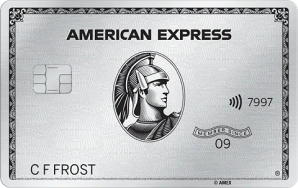Why you might want to get the Amex Platinum
The Platinum Card® from American Express comes with 5X points on flights and prepaid hotels, so it’s ideal for consumers who travel frequently.
It’s an especially good choice if your home airport has a Centurion lounge, as Platinum Card holders have access to any lounge in the Centurion network. The Amex Platinum Card even gives you access to Delta Sky Clubs when you take a Delta-operated flight scheduled on the same day. This card also comes loaded with valuable statement credits.
Bottom line: Amex Platinum is best for luxury travelers who can utilize specific statement credits and premium perks like exclusive airport lounge access.
Why you might want the Chase Sapphire Reserve instead
The Chase Sapphire Reserve® comes with plenty of travel perks, but it also offers 3X points on dining (& 10X on Chase Dining purchases), making it a good choice if you love to try new restaurants.
Occasionally, Chase increases the number of Chase Ultimate Rewards points available for specific categories, making it easier to maximize your benefits. This card even comes with 10X Chase Ultimate Rewards Points for all hotels and credit cards booked through Chase Travel. Note that you don’t start earning points on travel until after the $300 travel credit is spent each year.
Bottom line: Chase Sapphire Reserve is best for frequent travelers who enjoy dining out and prefer a flexible travel credit over oodles of specific statement credits.
Does it make sense to have both Amex Platinum and Chase Sapphire Reserve?
Due to the high annual fee for each card and an overlap in some benefits, it probably doesn’t make sense to have both the Amex Platinum and the Chase Sapphire Reserve.
The Amex Platinum has an annual fee of $695, while the Sapphire Reserve has an annual fee of $550, a total of $1,245. Most people won’t get more than $1,245 worth of benefits, so it’s best to pick one card and stick with it.
Amex Platinum vs. Chase Sapphire Reserve: Welcome offer
Winner: The Platinum Card® from American Express
When comparing the welcome offers of Amex Platinum vs. Chase Sapphire Reserve, it’s fully dependent on how you redeem your points. The Amex Platinum’s offer has the potential to be more valuable, though.
Amex Platinum Card:
If you open an Amex Platinum Card, you have the opportunity to earn 80,000 Membership Rewards Points by spending $8,000 on eligible purchases within your first 6 months of membership. As Membership Rewards points are typically worth between 0.5 cents and 2 cents each, this offer is worth roughly $560 to $1,600.
Chase Sapphire Reserve:
Chase offers 60,000 Chase Ultimate Rewards points if you spend $4,000 within 3 months. Since Chase Reserve points are worth between 1 and 1.5 cents each, this offer is worth $600 to $900.
Amex Platinum vs. Chase Sapphire Reserve: Rewards
Winner: Chase Sapphire Reserve®
The Platinum Card gives you more points on flights, but the Chase Sapphire Reserve gives you more points on prepaid hotels and rental cars. We’re giving this one to the Sapphire Reserve since it has more categories than just travel.
Amex Platinum Card:
- 5X points on flights booked directly with airlines or with American Express Travel (on up to $500,000 spent on these purchases per calendar year)
- 5X points on prepaid hotels booked through American Express Travel
- 1X points on all other eligible purchases
Chase Sapphire Reserve:
- 10X points on hotels and car rentals through the Chase Travel portal
- 10X points on Chase Dining purchases
- 5X points on flights booked through Chase
- 3X points on travel and dining
- 1X points on all other purchases
Note, however, that on the Reserve, you won’t start earning points on travel until the $300 annual travel statement credit is fully spent. The first $300 spent on travel each year will automatically go toward the statement credit.
Amex Platinum vs. Sapphire Reserve: Redeeming points
In terms of redeeming points, both cards perform about the same.
Chase Sapphire Reserve:
With the Sapphire Reserve, you can transfer points to several airline loyalty programs, including Air Canada, Air France, British Airways, Emirates, Southwest Airlines and Virgin Atlantic. You can also transfer points to three hotel partners: World of Hyatt, IHG One Rewards and Marriott Bonvoy. Or you can redeem your points toward travel, merchandise, as statement credits, and more.
Chase points are worth between 1 and 1.5 cents each, depending on how you redeem them.
Amex Platinum Card:
With the Amex Platinum, you can transfer points to multiple airline partners, including Air Canada, Delta, Emirates, Virgin Atlantic and JetBlue. You can also transfer points to the Choice Privileges, Marriott Bonvoy and Hilton Honors loyalty programs. Or you can redeem your points toward travel, as statement credits, and more.
Membership Rewards points are typically worth between 0.5 cents and 2 cents each, depending on how you redeem them.
Amex Platinum vs. Chase Sapphire Reserve: Travel perks
The Platinum Card and the Chase Sapphire Reserve card offer similar travel perks, but Amex comes out slightly ahead for its additional hotel perks and exclusive airport lounge access.
Airport lounge access
Winner: The Platinum Card® from American Express
Amex Platinum Card:
The Platinum Card gives you access to more than 40 American Express Centurion lounges, Priority Pass Select lounges (enrollment required), Delta Sky Clubs, and more. Terms apply.
Chase Sapphire Reserve:
With Chase, you get a complimentary Priority Pass membership, giving you access to more than 1,300 airport lounges worldwide. As a Chase member, you can also bring two guests to each lounge for no additional charge. American Express members have to pay a $50 fee for each adult guest and a $30 fee for each guest between the ages of 2 and 17.
Travel insurance
Winner: Chase Sapphire Reserve®
Chase Sapphire travel insurance offers several benefits to give you extra peace of mind every time you leave home. These benefits include:
- Travel accident insurance: $1 million
- Auto rental collision damage waiver: $75,000
- Baggage delays: $100 per day for a maximum of 5 days
- Emergency evacuation and transport: $100,000
- Emergency medical and dental: $2,500 with a $50 deductible
- Lost luggage: $3,000 per person for each trip
American Express offers the following insurance benefits* to its members:
- Lost baggage: $1,200 per trip
- Delayed/canceled flight: $250 per person for alternative travel expenses, meals or refreshments; $1,000 if your bag is delayed for more than 4 hours and you need to purchase essential clothing
- Emergency dental: $1,000
- Emergency prescription expenses: $1,000
- Emergency medical transportation: $100,000
- Travel accident insurance: $500,000
Chase comes out ahead in this category because it offers double the amount of travel accident insurance and lost baggage insurance.
Hotel perks
Winner: The Platinum Card® from American Express
Amex Platinum Card:
The American Express Platinum Card comes with several hotel benefits. You can enjoy special treatment at The Hotel Collection, with perks like late checkouts, free breakfasts, a $100 experience credit, and a complimentary room upgrade (when available, a 2-night minimum stay is required). Plus, you’ll get complimentary Marriott Gold Elite status and Hilton Gold status, both of which entitle you to additional benefits at these hotel chains. On top of that, you can get a $200 annual hotel statement credit when you book with Fine Hotels + Resorts or The Hotel Collection and use your card to pay the bill (minimum two-night stay required for The Hotel Collection).
Chase Sapphire Reserve:
In addition to 10X points on hotels booked through Chase Travel℠, the Sapphire Reserve comes with a $300 annual travel credit and gives you access to numerous perks at properties in The Luxury Resort & Hotel Collection. Sapphire Reserve doesn’t come with any hotel elite status perks, however.
Travel credits
Winner: Chase Sapphire Reserve®, since the annual travel credit is more flexible than Amex Platinum’s.
Amex Platinum Card:
- Up to a $100 fee credit for Global Entry or TSA PreCheck application
- $189 annual CLEAR Plus credit
- $200 annual airline credit to cover incidentals like baggage fees
- $200 annual credit for prepaid hotel bookings through AmEx Travel (Fine Hotels + Resorts or The Hotel Collection).
Chase Sapphire Reserve:
- $100 fee credit for Global Entry or TSA PreCheck
- $300 annual travel credit
Amex Platinum vs. Chase Sapphire Reserve: Other benefits
Winner: The Platinum Card® from American Express
Both cards also come with a variety of other benefits, but we’re giving this category’s win to the Amex Platinum card, strictly for the value of its additional benefits.
Amex Platinum Card:
- $300 a year Equinox credit
- $300 for a SoulCycle at-home bike
- $240 a year for eligible digital entertainment purchases
- $155 a year for a Walmart+ membership
- $100 a year at Saks Fifth Avenue
- $200 per year in Uber Cash
Chase Sapphire Reserve:
- Lyft Pink All Access membership
- Free DoorDash DashPass membership for at least a year (when you activate by December 31, 2024)
- Instacart+ membership (12 months free when activated before July 31, 2024)
- Instacart statement credits (earn up to $15 in statement credits per month, through July 2024)
Amex Platinum vs. Chase Sapphire Reserve: Rates & fees
Winner: Chase Sapphire Reserve®
Chase comes out ahead in this category due to its lower annual fee. The Amex Platinum Card has a $695 annual fee while the Chase Sapphire Reserve has a $550 annual fee, $145 less than the Platinum. Neither card has any foreign transaction fees.
If you want to add any authorized users, the Platinum Card charges $175 for 3, then $175 for each additional. The Chase Sapphire Reserve charges $75 for each authorized user.
(See Amex Platinum rates and fees)
Amex Platinum vs. Chase Sapphire Reserve: Eligibility
Winner: The Platinum Card® from American Express
Both cards require good credit scores, but the Chase Sapphire Reserve is slightly harder to get.
Before you apply for The Platinum Card, you should have a FICO score of at least 700. If you have another Amex credit card, you may already even have a pre-approved offer from American Express for the Amex Platinum card.
To be approved for the Chase Sapphire Reserve®, you generally need at least a 720.
It’s possible to get approved with slightly lower scores, but neither of these cards is for consumers with poor or average credit scores.
To see if you may be eligible for either of these cards, the CardMatch tool (see below) can help you know if you are pre-qualified, and may even offer you a higher welcome bonus!
Amex Platinum vs. Chase Sapphire Reserve: Security
Winner: The Platinum Card® from American Express
The Amex Platinum Card has a few more security features than the Chase Sapphire Reserve, but both companies do an excellent job guarding your personal information.
With the American Express Platinum Card, you can access the Global Assist Hotline, which provides emergency travel assistance. American Express also sends 24/7 fraud alerts, uses SafeKey to protect you while shopping and replaces lost and stolen cards within 48 hours.
Chase uses chip-enhanced security and offers fraud monitoring.
*Note: Eligibility and Benefit level varies by Card. Terms, Conditions, and Limitations Apply. Please visit americanexpress.com/benefitsguide for more details. Underwritten by Amex Assurance Company.
Bottom line: Should you get the Amex Platinum or the Sapphire Reserve?
If you’ve gotten to the end of this article and don’t have a clear choice in mind, consider this: what benefits do you prioritize— luxury perks to make your travels more comfortable or flexible rewards to choose what you want to do with them?
If you want luxury perks, your answer is the Amex Platinum Card, as it has benefits like exclusive airport lounge access, valuable statement credits, and hotel elite status.
If you prefer flexible rewards, the Chase Sapphire Reserve is where it’s at. With a $300 flexible annual statement credit and rewards in categories that go beyond travel, the Chase Reserve gives you the flexibility to choose how you want to earn and redeem your rewards.


































































































































































